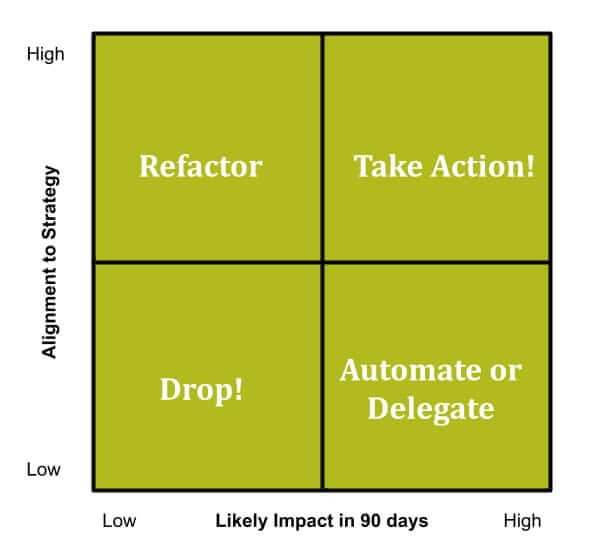How to do less: Trade overwhelm for immediate impact
If you’ve been reading for a while, you know I’m constantly beating the drum for you, as a leader, to do less. When I look at your to-do lists, I see more things to do than hours available to do them. How do we, as leaders, consistently identify the one or two things that deserve our true focus each day?
For years, the standard advice folks give for triaging our tasks is to use the Eisenhower Matrix, which separates tasks into four quadrants based on their urgency and importance. But it’s just not doing the job for us in 2025.
Let’s be honest, when we’re leading in the middle of a poly-crisis, the words “urgent” and “important” feel like they’ve lost their meaning. When the economy is in flux, our clients are getting laid off, and cash flow is tight, it feels impossible to step back and plan. But without some way to prioritize, we’re on a hamster wheel that won’t stop!
I got a fresh perspective recently while listening to Episode 48 of the Innovation Agility podcast. The guest, Lisa Nirell, had a simple tweak to the Eisenhower Matrix that has clarified my thinking and created a helpful new filter for action.
She swapped out the traditional axes for concepts that are more grounded in what makes a business truly win over time:
- She replaced “Important” with: “How aligned is this activity to our strategy?”
- She replaced “Urgent” with: “How likely is this to make an impact in the next 60 to 90 days?”
Now, instead of wrestling with vague feelings of urgency, we are invited into a conversation about strategy and near-term results.
This new matrix looks like this:

What the New Matrix Invites Us To Do
When we look through this new lens, a few things become clear:
- The “Take Action!” Box (High Alignment, High Impact): These are the things we want to be doing, and we can move them forward with confidence. This is where we feel the most agency.
- The “Drop!” Box (Low Alignment, Low Impact): Just like before, if something doesn’t move our strategy forward and won’t make an impact soon, this is an easy decision. We can let go of the baggage here.
The real difference lies in the other two quadrants:
1. Refactor (High Alignment, Low Impact)
These are the big, strategic projects—the deep work, the system overhaul, the long-term vision. They align perfectly with winning, but they won’t pay off for six months or a year. Many leaders put these off indefinitely because they never feel “urgent.”
The invitation here is to break it down. Can we find a piece of this initiative that will have a near-term impact, even a small one, within the next 60 to 90 days? Let’s do that piece, see how it goes, and keep the momentum moving toward the larger goal. This helps us build momentum, and the impact provides new insights into how strategic the larger project will be.
2. Automate or Delegate (Low Alignment, High Impact)
This is the stuff that genuinely delivers results (high impact) but doesn’t actually align with your specific way of winning (low alignment).
This is a great invitation to review your tools. What can be automated or streamlined by a new system? For everything else, this is the perfect opportunity to practice delegation and trust your team. When we shift these high-impact tasks to the right person or the right tool, we achieve the impact without sacrificing our focus on what truly matters to our strategic point of view.
The Foundation: Your Strategy
Of course, all of this work assumes you have a clear strategy.
But what is a strategy? It doesn’t have to be a 50-page binder. For our purposes, let’s think of it as your clear point of view on how your organization will win over the next 60 to 90 days.
What does winning look like for you and your team in the near term? How do you know when you’re getting closer to that win? If you don’t have a clear strategy that you are communicating to your team, substitute “growth” or “creating stability” for the word “strategy” and see if that is clearer than “importance.”
Developing that crystal-clear 90-day strategy is the natural next step, and I’ll take it up next week.
For now, I invite you to review your current to-do list using this new matrix. Does reframing “importance” as “alignment to strategy” help clear the decks for you? Does it become easier to see which items are genuinely aligned with moving your team forward, and which are simply busywork that can be dropped, delegated, or automated?
See if this helps you focus on the most valuable actions this week.